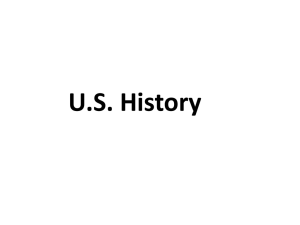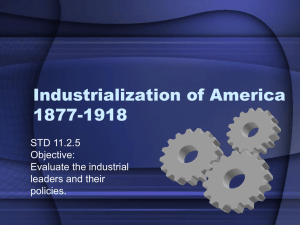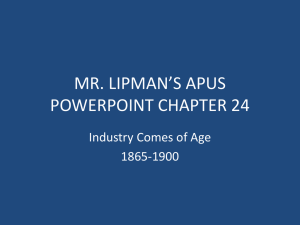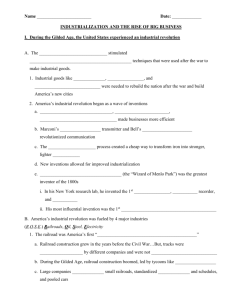Chapter 18 Study Guide
advertisement
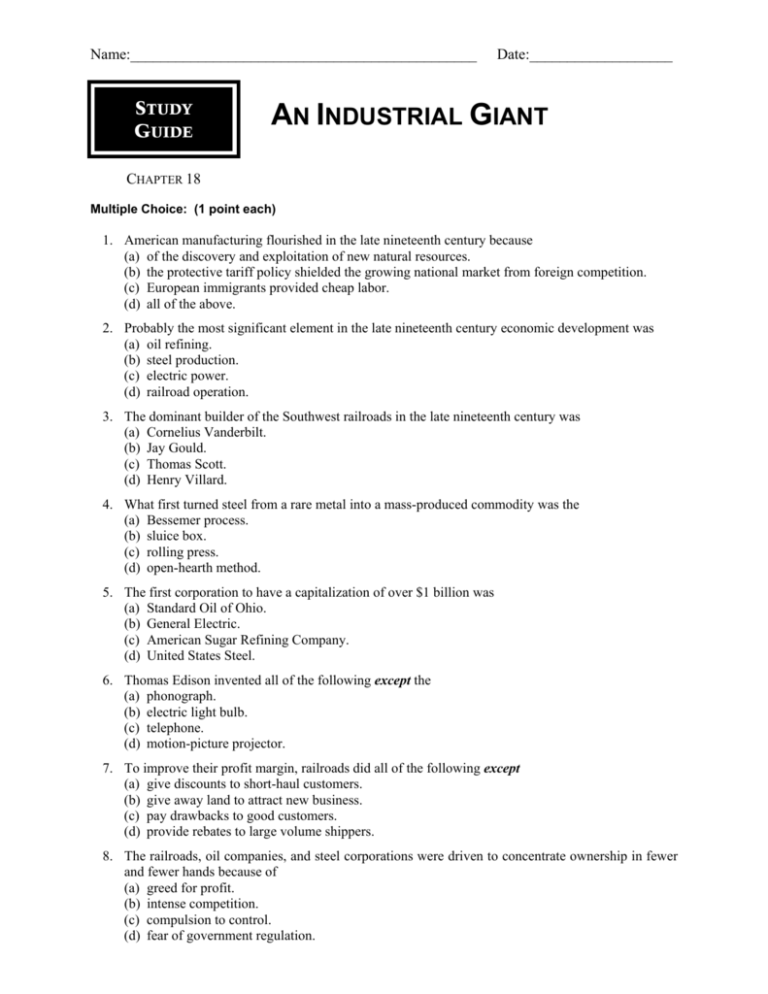
Name:______________________________________________ STUDY GUIDE Date:___________________ AN INDUSTRIAL GIANT CHAPTER 18 Multiple Choice: (1 point each) 1. American manufacturing flourished in the late nineteenth century because (a) of the discovery and exploitation of new natural resources. (b) the protective tariff policy shielded the growing national market from foreign competition. (c) European immigrants provided cheap labor. (d) all of the above. 2. Probably the most significant element in the late nineteenth century economic development was (a) oil refining. (b) steel production. (c) electric power. (d) railroad operation. 3. The dominant builder of the Southwest railroads in the late nineteenth century was (a) Cornelius Vanderbilt. (b) Jay Gould. (c) Thomas Scott. (d) Henry Villard. 4. What first turned steel from a rare metal into a mass-produced commodity was the (a) Bessemer process. (b) sluice box. (c) rolling press. (d) open-hearth method. 5. The first corporation to have a capitalization of over $1 billion was (a) Standard Oil of Ohio. (b) General Electric. (c) American Sugar Refining Company. (d) United States Steel. 6. Thomas Edison invented all of the following except the (a) phonograph. (b) electric light bulb. (c) telephone. (d) motion-picture projector. 7. To improve their profit margin, railroads did all of the following except (a) give discounts to short-haul customers. (b) give away land to attract new business. (c) pay drawbacks to good customers. (d) provide rebates to large volume shippers. 8. The railroads, oil companies, and steel corporations were driven to concentrate ownership in fewer and fewer hands because of (a) greed for profit. (b) intense competition. (c) compulsion to control. (d) fear of government regulation. THE AMERICAN NATION CHAPTER 18 STUDY GUIDE 2 9. Andrew Carnegie’s success in the steel industry was largely due to his (a) his grasp of the importance of technological improvement. (b) his ability to choose good subordinates. (c) his ruthless competitiveness. (d) all of the above. 10. The first oil well drilled in the United States was in (a) Oklahoma. (b) Ohio. (c) Texas. (d) Pennsylvania. 11. The primary goal of John D. Rockefeller’s trust was to (a) reduce production. (b) monopolize refining. (c) make operations more efficient. (d) relieve himself of management responsibilities. 12. What most concerned Americans about business combinations was that they would (a) destroy economic opportunity. (b) raise prices. (c) invite government regulation. (d) not last. 13. The primary message of the “Gospel of Wealth” was that (a) “the wrong and evil of the money-piling tendency is changing laws, government, morals, and giving all power to the rich.” (b) “unrestrained competition is un-Christian; state aid and regulation is an indispensible condition to human progress.” (c) “the rich must use their money in the manner which is best calculated to produce the most beneficial results to the community.” (d) “within a few years, most of the wealth and talent of our country will be on one side while arrayed on the other will be the great mass of the people.” 14. The advocate of a “single tax” on property to alleviate the maldistribution of wealth and provide public funds for schools and other social services was (a) Laurence Gronlund in The Cooperative Commonwealth. (b) Edward Bellamy in Looking Backward, 2000-1887. (c) Henry George in Progress and Poverty. (d) Henry Demarest Lloyd in Wealth Against Commonwealth. 15. The Supreme Court’s ruling in Munn v. Illinois (a) upheld the right of organized labor to bargain collectively. (b) asserted that only Congress could regulate interstate commerce. (c) permitted state legislatures to regulate railroad rates within a state. (d) determined that the Sherman Anti-Trust Act was unconstitutional. 16. All of the following are true of the Sherman Anti-Trust Act except (a) it was supposed to restore competition. (b) it was emasculated in United States v. E. C. Knight Company. (c) it forbade business combinations in the form of trusts that restrained trade. (d) it led to a sharp decline in the formation of company mergers. 17. A strong message of the Knights of Labor was that (a) workers must not resign themselves to remaining wage earners all their lives. (b) strikes should be used vigorously to gain progress for their members. (c) union membership should be restricted to skilled crafts workers. (d) unions were better off not supporting political objectives. THE AMERICAN NATION CHAPTER 18 STUDY GUIDE 3 18. The Haymarket Riot (a) resulted when someone threw a bomb among the policemen at a mass meeting in Chicago. (b) was caused by the Knights of Labor. (c) led to the collapse of the American Railway Union. (d) was all of the above. 19. Which of these statements is false? (a) The 1877 Southwestern rail strike brought train traffic to a standstill, prompting President Hayes to send in federal troops. (b) The assassination of steel executive Henry Clay Frick ended labor unrest at the Homestead plant near Pittsburgh. (c) Eugene V. Debs was jailed for disobeying a federal injunction issued by the courts in the Pullman strike. (d) The goal of most strikers in the Haymarket affair was the eight-hour day. 20. Which union was the most successful in the late nineteenth century? (a) American Railway Union (b) American Federation of Labor (c) Knights of Labor (d) National Labor Union 21. During the Gilded Age, most of the railroad barons (a) rejected government assistance. (b) built their railroads with government assistance. (c) relied exclusively on Chinese labor. (d) refused to get involved in politics. 22. The national government helped finance transcontinental railroad construction in the late nineteenth century by providing railroad corporations with (a) cash grants from new taxes. (b) land grants. (c) cash grants from higher tariffs. (d) reduced prices on iron and steel. 23. Agreements between railroad corporations to divide the business in a given area and share the profits were called (a) pools. (b) trusts. (c) rebates. (d) interlocking directories. 24. The first federal regulatory agency designed to protect the public interest from business combinations was the (a) Federal Trade Commission. (b) Interstate Commerce Commission. (c) Consumer Affairs Commission. (d) Federal Anti-Trust Commission. 25. After the Civil War, the plentiful supply of unskilled labor in the United States (a) helped build the nation into an industrial giant. (b) was not a significant force, since industrialization required skilled labor. (c) came almost exclusively from rural America. (d) increasingly found work in agriculture. 26. One of the methods that post-Civil War business leaders used to increase their profits was (a) increased competition. (b) support for the idea of a centrally planned economy. (c) elimination of as much competition as possible. (d) doing away with the tactic of vertical integration. THE AMERICAN NATION CHAPTER 18 STUDY GUIDE 4 27. The ___ Amendment was especially helpful to giant corporations when defending themselves against regulation by state governments. (a) Fourteenth (b) Fifteenth (c) Sixteenth (d) Seventeenth 28. The Sherman Anti-Trust Act was used primarily to curb the power of (a) manufacturing corporations. (b) labor unions. (c) state legislatures. (d) railroad corporations. 29. The railroads affected the concept of time in the United States by (a) introducing regularly scheduled departures and arrivals on railroad timetables. (b) introducing the concept of daylight savings time. (c) introducing four standardized time zones across the country. (d) turning travel that had once taken days into a matter of hours. 30. Andrew Carnegie’s industrial system of “vertical integration” referred to (a) the construction of large, vertical steel factories in Pittsburgh and elsewhere. (b) the cooperation between manufacturers like Carnegie and financiers like J. P. Morgan. (c) the integration of diverse immigrant ethnic groups into the steel industry labor force. (d) the combination of all phases of industry from mining to manufacturing into one organization. 31. Which of the following explains why unions did not have much success in the nineteenth century? (a) Workers had little interest in joining unions because their real wages were rising and their living conditions were improving. (b) Most workers did not remain in the working class permanently but quickly went on to become self-employed farmers or small businessmen. (c) Labor and management saw eye-to-eye on most issues, and as a result there was little need for union activity. (d) Public, employer, and government hostility toward unions as well as divisions within the labor force impeded union growth. 32. In the Pullman strike (a) the federal government used an injunction and troops against workers and threw the union leader in jail. (b) the state of Illinois tried eight anarchists for throwing a bomb, found them guilty, and executed four of them. (c) workers walked out to protest conditions at Carnegie’s steel mills but eventually returned to work without gaining any improvements. (d) the Knights of Labor led railroad workers in demands for an eight-hour day and finally won this concession from the railroads. 33. Industrial growth was concentrated in the (a) Southwest. (b) Northeast. (c) Pacific. (d) Southeast. (e) Midwest. 34. The two transcontinental railroad lines met at (a) Sacramento, California. (b) Reno, Nevada. (c) Promontory, Utah. (d) Santa Fe, New Mexico. (e) Salt Lake City, Utah. THE AMERICAN NATION CHAPTER 18 STUDY GUIDE 5 35. Which of the following individuals is incorrectly associated with the industry he helped to found? (a) Andrew Carnegie—steel (b) J. P. Morgan—finance (c) Henry Bessemer—railroads (d) John D. Rockefeller—oil (e) Cornelius Vanderbilt—railroads 36. Standard Oil is an example of (a) a trust. (b) pooling. (c) a conglomerate. (d) a holding company. (e) vertical integration. 37. The greatest inventor of the late nineteenth and early twentieth century America was (a) Cyrus Field. (b) Thomas Edison. (c) Henry Bessemer. (d) J. P. Morgan. (e) George Westinghouse. 38. The leader of the Knights of Labor was (a) Jay Gould. (b) Samuel Gompers. (c) Terence Powderly. (d) John L. Lewis. (e) Eugene V. Debs. 39. As the leader of the American Federation of Labor, he tried to achieve pragmatic goals for workers. (a) Terence Powderly (b) Samuel Gompers (c) John L. Lewis (d) Uriah S. Stephens (e) Eugene V. Debs 40. The Great Strike of 1877, in which more than fifty people died, involved (a) steel workers. (b) cowboys. (c) railroad workers. (d) oil workers. (e) textile workers. True/False: Answer “A” for true and “B” for false. 41. Private railroad companies built the transcontinental rail lines without the assistance of the federal government. 42. The railroads created an integrated national market, stimulated the growth of cities, and encouraged European immigration. 43. The Rockefeller oil company’s technique of “horizontal integration” involved combining into one organization all the phases of manufacturing from the raw material to the customer. 44. Corporations used the Fourteenth Amendment and sympathetic court rulings to prevent much effective government regulations of their activities. THE AMERICAN NATION CHAPTER 18 STUDY GUIDE 6 45. Industrialization generally gave the industrial wage earner greater status and control over his or her own life. 46. The Knights of Labor organized skilled and unskilled workers, blacks and whites, women and men. 47. The Knights of Labor were severely hurt by the Haymarket Square episode, even though they had no connection with the bombing. 48. The American Federation of Labor succeeded by concentrating on skilled, white, male craft workers and generally ignored unskilled, female, and black workers. 49. Immigration had little impact on the economic development in the late nineteenth century. 50. The American Railway Association was largely responsible for dividing the United States into the time zones that exist today.



